One of the weak links of the M16 platform has always been the magazine design. The double column feed makes the system prone to malfunction should there be any dimensional problem with the magazine. Thankfully, there are more options for good magazines than ever before. Aluminum GI magazines have better springs, followers, and are built to as high a standard as ever, and we now have excellent choices in polymer magazines.
With that in mind, I decided to do a simple durability test of four popular magazines: the USGI aluminum magazine, the legacy PMAG, the new PMAG GEN M3, and the latest TangoDown ARC Mark 2 magazine.
I structured the test around conditions that the magazine might likely be subjected to: a drop from weapon height onto concrete. The worst case scenario would be that the magazine falls on its feed lips. So that is what I did. First I measured the feed lips of each magazine loaded to capacity. The magazine can hold 30 rounds, so that is what I loaded them to. I understand that many SOP’s designate the magazines be loaded to 28 rounds, but I was looking to test the magazine in a worst case scenario, so 30 rounds it was.
Once loaded to 30 rounds, the feed lip dimensions were:
USGI .471″
PMAG .453″
PMAG GEN M3 .443″
ARC Mk 2 .461″
First, I dropped the USGI magazine. The magazine landed on the right feed lip and immediately ejected a live round. I measured the feed lips again and they had already spread .029″ from one drop. After five drops, the feed lips had spread a total of .054″ and the right feed lip was quite deformed.
Next were the polymer magazines. Both generations of the PMAG began cracking after the first drop, but did neither magazine showed the massive deformation that the USGI magazine exhibited. After one drop, the original PMAG spread .008″ to a total width of .465″. After five drops the lips spread to .485″ for a total of .028″ of spread.
The PMAG GEN M3 spread .013″ after one drop and .019 after five drops.
The TangoDown ARC magazine performed the best of all. It’s feed lips spread about the same as the PMAG GEN M3 (.009″ after the first drop and .019″ after the second drop), the magazine did not show any signs of cracks.
To recap here are the results after five drops onto concrete:
USGI: .054″ total spread, no cracks, severe feed lip deformation
PMAG: .028″ total spread, small crack in spine, very minor feed lip deformation
PMAG GEN M3: .019″ total spread, moderate crack on right feed lip, very minor feed lip deformation
TangoDown ARC Mark 2: .019″ total spread, no cracks, no feed lip deformation (only minor abrasion from impact)
At the range: The USGI magazine was so deformed it would not go into the magazine well. It was no longer serviceable. All three polymer mags functioned normally both slow and rapid fire. The ARC magazine would no longer drop free when full or empty. The PMAGs (both generations) failed to drop free when partially full, but both dropped free from the weapon when empty, as the feed lips were no longer spread apart (due to the cracks) when there was no load on them.
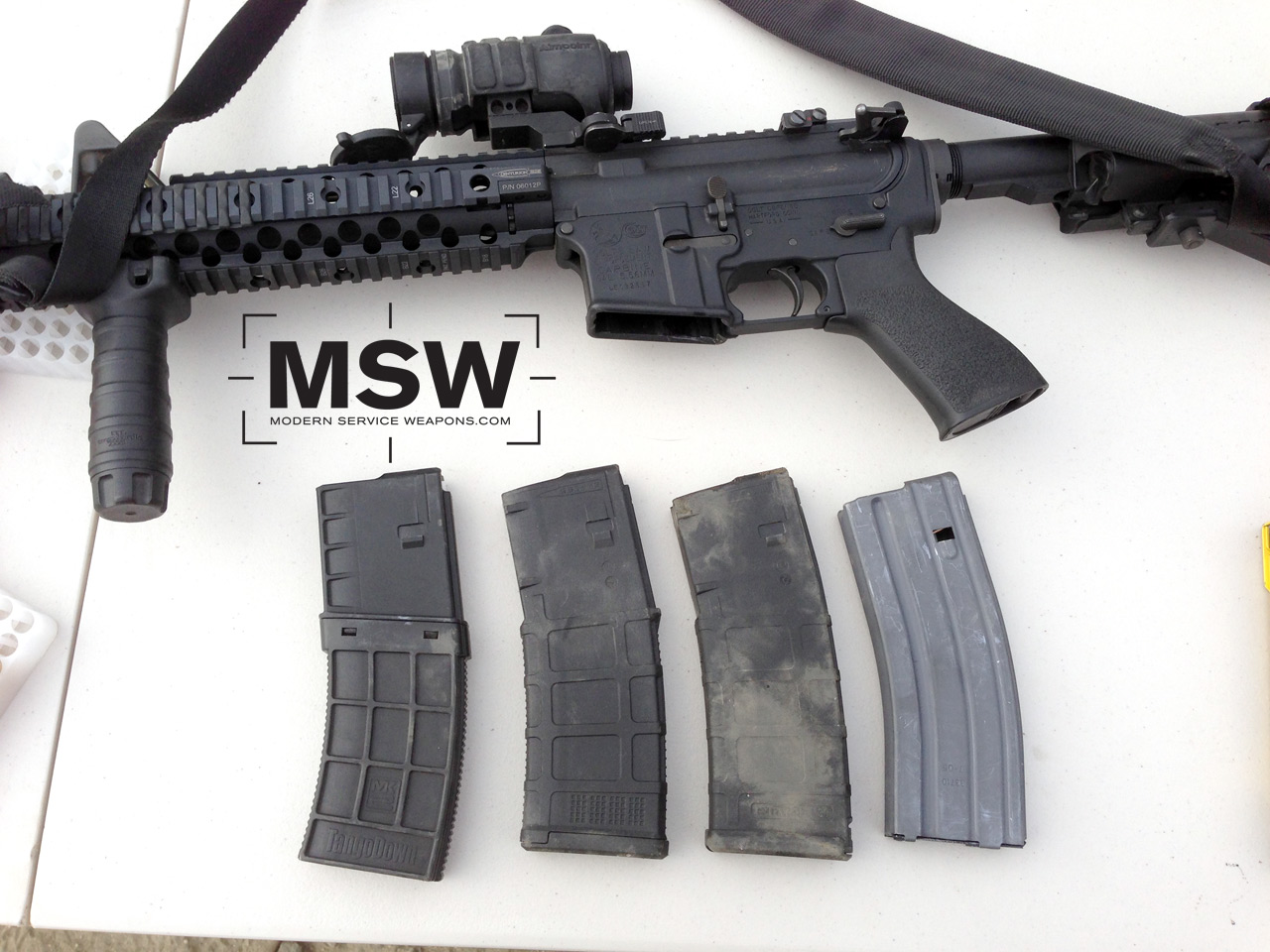
All four magazines after test firing. The polymer mags were still serviceable but the aluminum USGI magazine could not even be forced into the magazine well of my Colt LE6920.
CONCLUSION: For this type of test, all of the polymer mags out performed aluminum USGI magazines. It’s important to take these results with a grain of salt as there were a number of variables I didn’t account for, such as exactly how magazine landed. Some may have landed only one one feed lip, while others may have landed squarely on both, etc., But based on this one data point, it seems that any of the polymer magazines appear to be more durable than the USGI magazine in this area. Other tests, such as long term storage, may yield different (or similar) results.
SOURCES:
http://www.tangodown.com



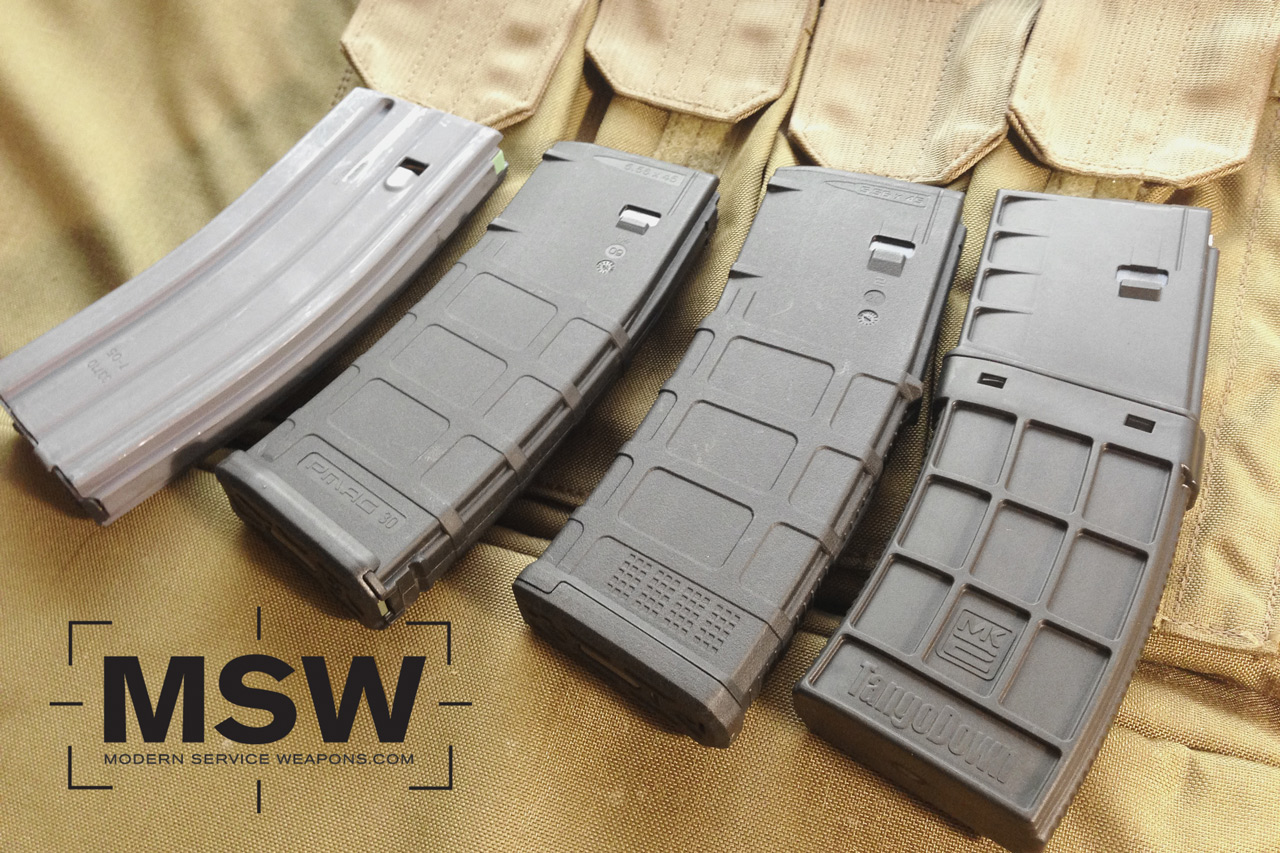
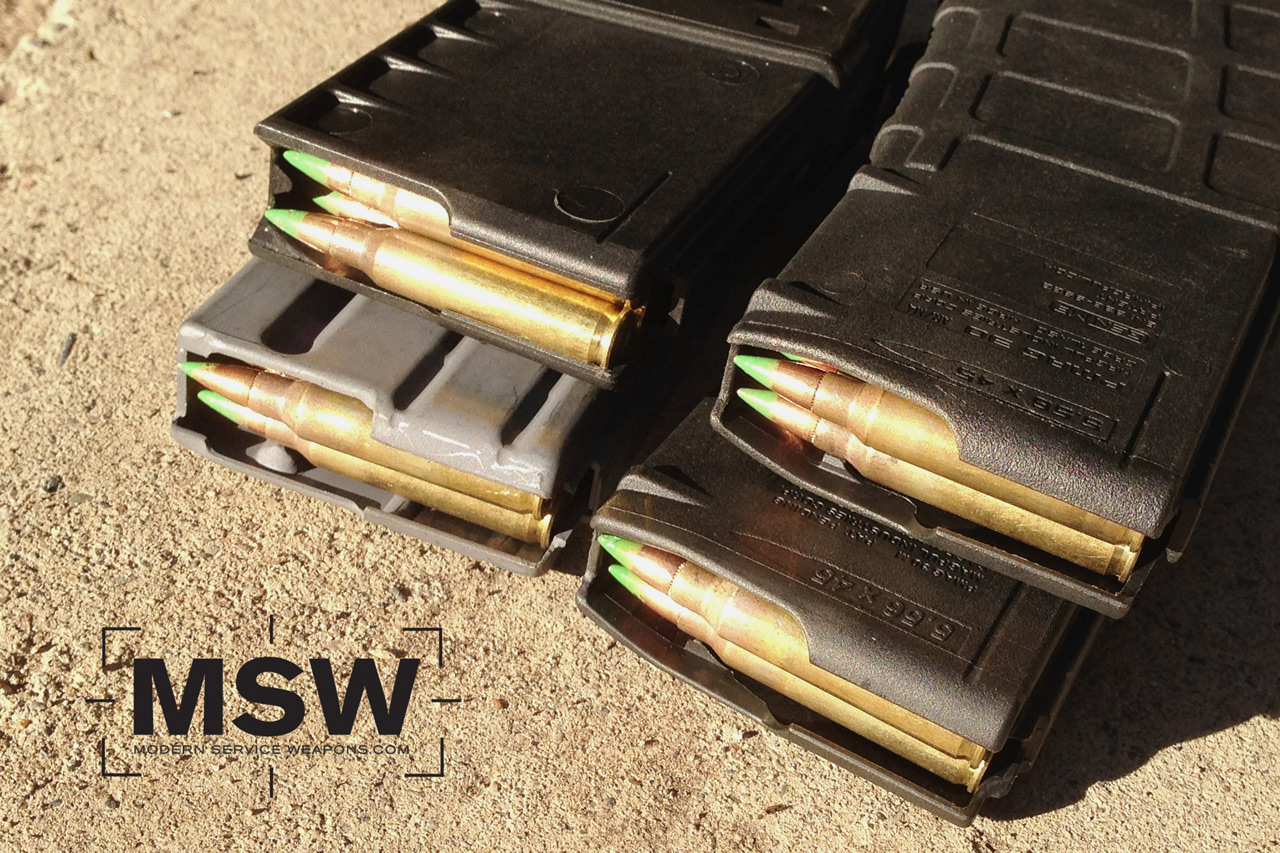
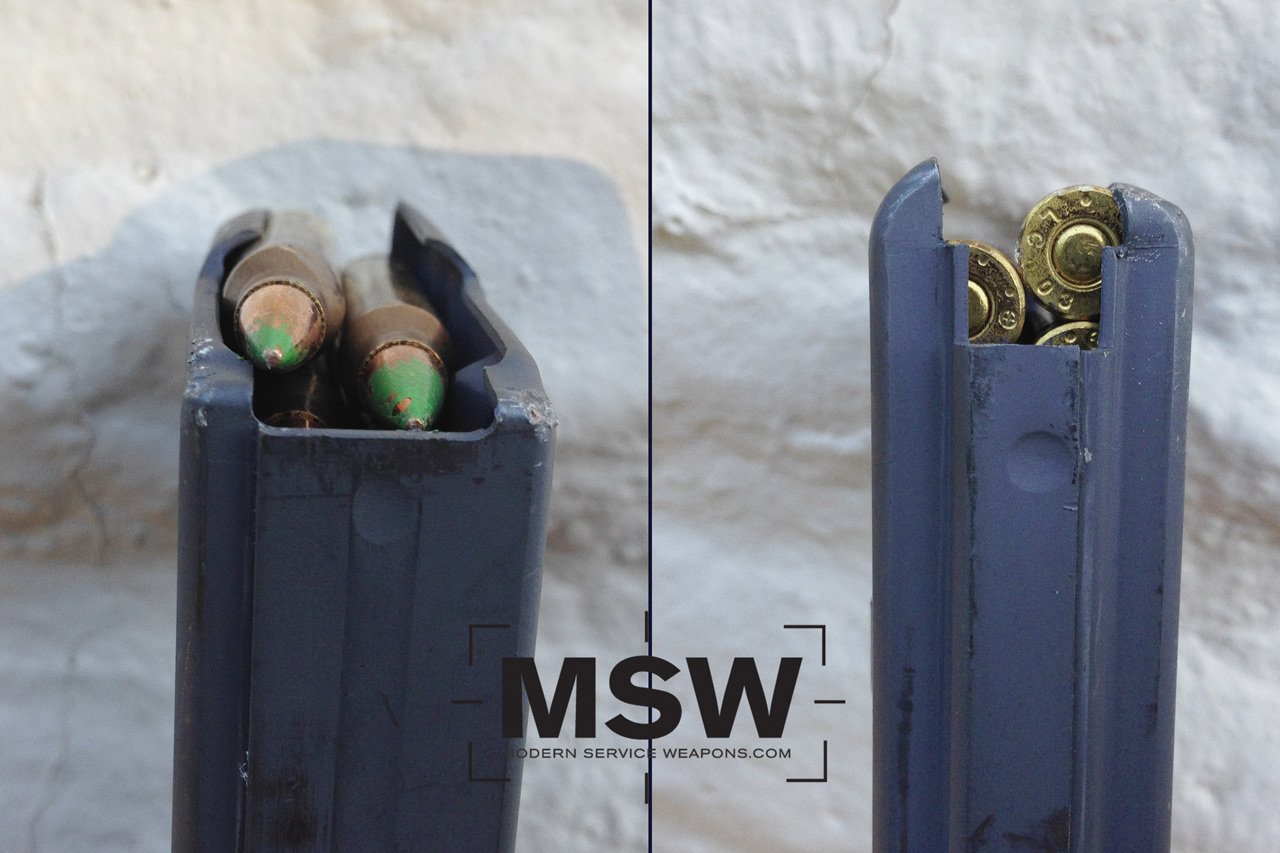
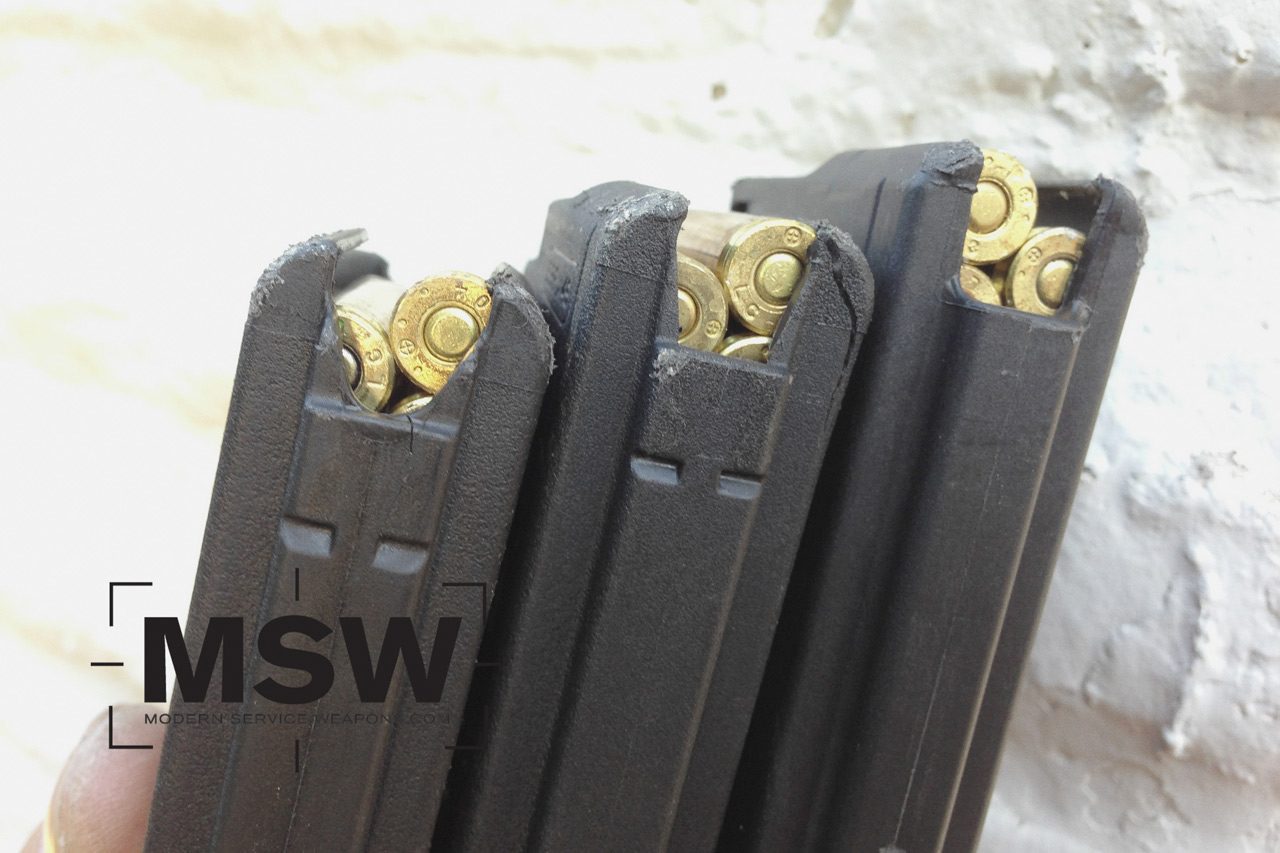
Has anyone had an experience with the Lancer polymer magazine, and if so, what were your thoughts? I was given one for T&E, and literally threw it as high in the air as I could, fully and partially loaded, stomped on it, and threw it downrange, immediately picking it up, loading it, and firing the rounds inside without issue. This was a brief torture session, but I was favorably impressed. Anyone else?
Haven’t had any opportunity to try one.
Edited to Add: I just got one to test and will put it in the cycle. I will report back with results.
Regarding the Lancer L5 magazine, I have had one for a few years now. It has seen use in both formal training and structured practice. Thus far, as a sample of one, it has been fine; nothing about it stands out in a negative fashion.
Nicely done article, Tim, in the best “evidence-based” view of equipment performance as opposed to anecdotal mumblings.
We should bear in mind that Eugene Stoner intended the 20 round aluminum magazines of the original AR15 design to be disposable battlefield items. They were not meant to be reloaded. That said, I agree with Tim that the aluminum magazines available today are better than ever, especially with the Magpul followers in them. I have mothballed the majority of mine (except for a few for training)due to the abundance of good polymer magazines now saturating the market. At Larry Vickers’ carbine class he stated he still uses the Colt-supplied AR magazines without worry, I believe the NHMG is one brand. The body is marked with a 33710 stamp and year of manufacture.
This article reinforces the need to have different magazine sets, one for training and one for “go time.” You can abuse the training set without worry whether it will costy your life in an actual punch-up. Inspect your gear. It’s an old adage by now not to fall in love with your magazines. The first time they fail in training, smash them with a boot or slam them in a door. Don’t endanger another shooter with a subpar magazine.
I’m wondering what the recent Marine Corps edict against use of polymer magazines in their M16/M4 family of weapons will hold. More polymer mags on the market? Heaps of lightly used USMC mags? Less availability of the GI mags?
First the US Army banned polymer mags last spring, now the Marines – despite the fact that each branch’s most active shooters (SOCOM) have been using them successfully in combat for a few years. If I were the cynical type, I’d wonder if there were some political pressure being applied to protect some manufacturer’s contract.
It’s worth noting SOCOM elements are not subject to these bans.
The focus of the Army ban was that none of the plastic mags had been officially tested and approved, there was no doubt that some plastic mags are absolutely great — others not so much. Given that any large organization needs to keep its rules simple, the easy one-size-fits-all solution was to ban ALL non-issue mags (which was in line with the Army’s other policies about weapon parts and accessories: ONLY issue stuff is allowed, no matter how much better any of the unofficial toys might be)
The real test of feed lip damage is whether it produces failure-to-feed. It would have been nice to fire the loaded magazine to check function. If it didn’t double-feed, drop it again and retest.
If you read the article, each magazine was test fired after the five drops onto the feed lips.
I am curious about some of the steel magazines that are on the market. Do these handle rough treatment any better than the aluminum or plastic mags?
Any chance you can perform a similar test on the E-Lander, C Products, FN and HK mags?
Thank you.
I have some bit of experience with the HK mags, and they’ll dent as well. The key part to remember about these drop tests is that polymer has a certain amount of resiliency and will spring back from impact, while the thin metal of the magazines tends not to spring back as much.
I’m just wondering what height you dropped the mags at? Have you been able to do any cold weather drop tests? Thanks.
Sorry about that! I thought I had put that in the article. The magazines were dropped at typical weapon height, which for me is 4 feet. It doesn’t get very cold here in Southern California so no cold weather tests!
Nice test, the results are as I would have guessed.
The right material for the right application.
Thx!
Pingback: Magpul GEN 3 mags w/ Hk 416 - Page 5
I’m a US Army Infantry Squad Leader and I was issued a set of Magpul Gen 1 PMags before my last deployment to Afghanistan (June 09-June 10) and found the exact same results. I rarely dropped a mag (on the ground), but I did find from day to day patrols, ingress/egress from vehicles, “hitting the dirt” in a fire fight, mag changes, and plain old wear and tear the same cracks that developed as seen here (when loaded with 28 rounds a piece).
I had to eventually “retire” my PMags and return to the USGI aluminum mags or H&K steel mags, as the PMags would fail to feed and caused stoppages . . . which is a huge pain in the ass when returning fire. Another issue I had with the Gen 1 PMags was the fact that they seemed to be oversized in the mag-well and I had to ram them home when seating them in my (GI Colt) M4. They didn’t slide in easily like the USGI aluminums or my H&K “steelies,” and you had to really give them a “smack” to seat them in completely as well . . . I had a PMag fall out more than a few times because I thought it was seated correctly.
With the PMags, USGI aluminums, and H&K “steelies” now “retired” or used solely as backups (in case of loss or breakage), I’ve got a full set (8X) of Lancer L5 magazines. Been 8 months now on deployment with no issues whatsoever. Even after wear and tear and general use: mag changes are quick and clean, the mags seat easily with no more effort than a regular USGI aluminum, they are lighter (weight) than the Gen 1 PMags, the have always fed correctly and I’ve had no stoppages whatsoever.
Thanks for sharing your experiences with the PMAG. As for the HK SA80 magazines, I have not found them to be superior even to the GI mags. They are heavier and the feed lips seem to bend or dent just as easily. The follower is more stable, but the springs take a set faster and after a short usage cycle, they fail to lock the bolt open on an empty magazine. My money is better spent on GI mags, though all mags have suddenly become hard to come by…
I found the same thing with both the HK SA80s and GI mag, with lip dents and deterioration. And damn, those HKs are ridiculously heavy! Empty they weighed nearly as much as a half filled GI mag.
Wish I could do such a test or buy new mags. Living in NY I am stuck with my limited supply of pre bans. Sorry to say but everyone may soon be facing nationwide the same issues we have here. I am lucky to have about 30
Pre bans mostly 20 Rounders, and have to be satisfied with the gi alloy mags wether I like it or not
I feel your pain. That said, I would not feel bad about using aluminum USGI magazines as those are still my default mags.
This article reinforces the need to have different magazine sets, one for training and one for “go time.” You can abuse the training set without worry whether it will costy your life in an actual punch-up. Inspect your gear. It’s an old adage by now not to fall in love with your magazines. The first time they fail in training, smash them with a boot or slam them in a door. Don’t endanger another shooter with a subpar magazine.